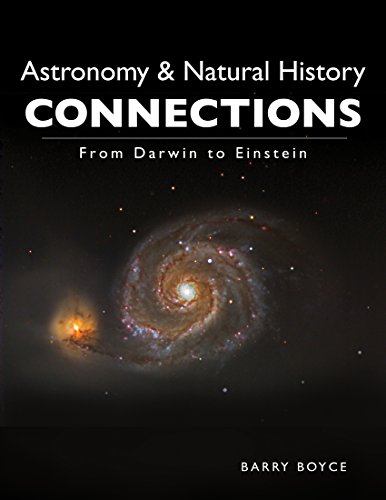
Astronomy and Natural History Connections: From Darwin to Einstein by Barry Boyce constitutes a highly readable tour of the natural world from the earth to the heavens and beyond, led by a seasoned guide.
Barry Boyce developed his fascination for his vastly variegated subject matter when he first visited the Galápagos Islands and fell in love with the place. He is a natural teacher – his technique for imparting information combines a wide range of knowledge, a good ear for jargon and buzzwords, and a sharp wit.
The book opens as he is about to do something he has done many times before – lead a class on astronomy at the Mount Lemmon Sky Center in Arizona. He points out that Arizona is a sort of mecca for astronomers both professional and amateur, with its clear dry air and many mountain peaks. Stars and their “twinkling” effect can best be seen from higher elevations, imaging best at 30 degrees above the horizon.
In this segment, Boyce poses mildly tricky questions and uses practical examples to give this audience a sense of the size and scale of the Universe; individual stars in a constellation, for example, may be light-years apart. In a history of astronomy, he notes that ancient cultures regarded the stars as sources of both scientific and religious understanding, often – like the Babylonians, Chinese and Greeks – linking astronomy and astrology.
From the heavens, Boyce moves down to earth, often citing phenomena observable in the Galápagos chain in his many descriptions of animal species – though he wants us to know that there is really no definition of “species.” We learn why the Blue-Footed Booby (a bird) has blue feet (courtship), what birds’ wings were originally intended for (gliding, flapping and – courtship) and why animals migrate (climate change and – courtship). We are gradually led to definitions of astronomical terms (with photographic illustrations) like Quark, Black Hole, Red Giant and White Dwarf, and to speculation about life beyond our planet and what time travel might really entail. Along the way he informs us that Darwin never used the term “survival of the fittest” and that Einstein didn’t care much for mathematics.
Boyce’s prose is both erudite and charming, and his fields of expertise are remarkable for their number and complexity. He has logged in thirty years of experience as a teacher and guide, leading expeditions in the Galapagos Islands, the Norwegian Arctic and the Antarctic, and that experience shows throughout this book, which is a reflection of hands-on knowledge, and not just textbook scholarship.
Noting that many of his students want to take photographs of an eclipse but not to go a step or two further and understand and appreciate other celestial events, he makes a great effort to keep his material enjoyable as well as informative, and he succeeds in that intention. The book reads like an introductory course by your favorite teacher. In that regard, it’s not necessarily a work for those familiar with the ground he is covering, but there is such a wealth and breadth of information here that any reader is bound to find something of interest.
It would be impossible to make one’s way through this engaging treatment of two diverse areas of study without absorbing quite a lot of amazing facts, and feeling good about the process. Constructing the unusual linkage between earth science and star gazing, Boyce leaves the reader with a sense of the wonders of both. Astronomy and Natural History Connections is highly recommended for those who love science and even those who have not enjoyed the subject in the past, as it’s an inspiring work that is both far-reaching and accessible.
Book Links
STAR RATING
Design
Content
Editing
Get an Editorial Review | Get Amazon Sales & Reviews | Get Edited | Get Beta Readers | Enter the SPR Book Awards | Other Marketing Services























Leave A Comment